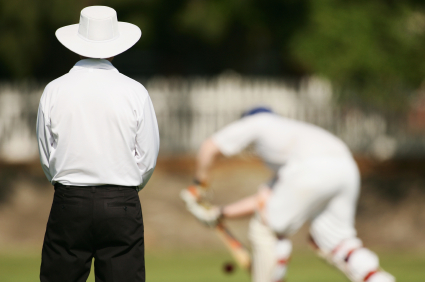Don't be a bad stand-in umpire
 Players, coaches or spectators roped in to umpire club cricket matches all want the same thing: To keep mistakes to the minimum and let the players enjoy the match. But it's tricky if you are not a qualified umpire.
Players, coaches or spectators roped in to umpire club cricket matches all want the same thing: To keep mistakes to the minimum and let the players enjoy the match. But it's tricky if you are not a qualified umpire.
No wonder you are a little reluctant to do it.
You can do a good job without having to memorise the Laws, a little preparation and application of common sense can go a long way to stopping you making the wrong decisions when under pressure.
Have a good rapport with players
Applying the Laws is only one part of the umpire's job. As much as possible he or she should look to let the players play the game without being overly officious. This in itself will improve the goodwill between you and the players, reducing the chance of someone feeling you are acting unfairly.
You can add to this by being polite. Its good manners to answer every appeal (even if it's not out), or call 'over' loud enough for everyone to hear. If a player is questioning your decisions, stay firm and tell him or her that they may not agree, but a decision has been made so the game must continue.
There are some simple things that you should be clear about before agreeing to umpire:
- Having counters to count the balls in the over (stones or coins will do). Most umpires also get in the habit of checking with the other umpire when there are 1 or 2 balls to go in the over.
- Stand close enough to see everything from either umpiring position. It's also important to move into position quickly for run out appeals. If you are at square leg you can walk in a few paces, if you are at the bowler's end you move to level with the popping crease on the same side as the ball has gone.
- Be comfortable with what counts as a no ball. This can be front or back foot, full pitched or too many bounces.
- Be aware of what counts as a wide. In most club games a wide is a ball that the batsman can't hit from his normal stance. However, if he moves you must take this into account.
Know the 4 steps of LBW appeals
LBW appeals are the most difficult to deal with because they all take an element of guesswork. To make it easier, there are 4 questions you need to ask before deciding if the batsman is out. You must answer 'yes' to all these questions:
- Did the ball pitch in line between wicket and wicket (or on the off side)? If it pitches outside leg stump it can't be out.
- Did the ball hit the pad first?
- Was the interception between wicket and wicket? The ball has to hit the pad between wicket and wicket if the batsman was playing a shot. If he was not playing a shot (for example leaving the ball) the ball can hit the pad 'outside the line' on the off side.
- Would the ball have hit the stumps? Based on your judgement of where the ball would have gone if it had not hit the pad you need to decide if it was going on to hit the stumps. Take into account how much the ball is moving, how far forward the batsman is playing (the further forward the harder to judge) and the height of the ball on impact.
Make it a point before you go to umpire that you know any rules specific to the competition or to the ground.
For example, some grounds have trees within the boundary. Different clubs play this obstruction in different ways (a clean hit on it may be four or may be six). Also, limited over games often have increased fielding restrictions.
While this is a far from comprehensive guide to being an umpire, applying these basics will make things run smooth more often than running rough. More difficult or rare situations might require the skills of a qualified umpire (or a Laws anorak).
If you want more detail on being stand-in umpire, check out the interactive course on PitchVision Academy: The Umpiring Survival Guide for Players, Coaches and Non-Umpires. It's designed to cover the basics of umpiring for people who have to do it but don't want to go through a full umpiring qualification.
- Login to post comments

